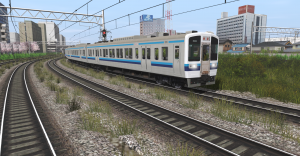
All the necessary dependencies are included in this .rar, included in the original content’s package or avaible on the DLS.
DOWNLOAD
In case of missing dependenices download this.
The 213 Series bears the distinction of having been the last entirely new series developed by JNR – mere months before the national railways’ privatization. The 213 Series was intended for rapid service on the Seto-Ooashi Line, wich was to be routed via the (then) under-construction Great Seto Bridge, a 13 kilometers long concatenation of six suspended bridges that was to run between Honshu and Shikoku. With it’s two-deck configuration (the upper one for automobile traffic and the lower one for railway services), the Great Seto Bridge was intended to replace the existing slow ferries (operated by JNR itself) between Takamatsu and Uno, where passengers could change to a Uno Line train to Okayama.
Crossing from Honshu to Shikoku took about one hour via the ferry. The bridge was supposed to bring the time needed to cross the strait down to just 20 minutes.
Roughly, the concept of the 213 Series was to be to the 211 Series what the 117 Series was to the 115 Series – in other words, a technically as-similar-as-possible, two-doors, cross-seating fitted rapid service derivative of the latter.
However, to contain costs, the 213 Series was designed to be even more similar to the 211 Series, to the point of being nearly identical as far as technical equipment went. In fact, the 211 and 213 Series share the entirety of their technical components, including the same bogeys, pantographs, motors, traction control system, doors, driving desks, 20m-long stainless steel bodyshell design, FRP front mask and so on.
However there were several differences as well: besides the more obvious ones (two doors per side instead of three, cars fully fitted with a cross-seating arrangment as opposed to the 211s’ semi-cross or longitudinal seating arrangment and the wider passenger windows), the 213 Series also sported some less subtle differences, such as the lowered assistant drivers’ front window (in a fashion similar to the future JR Central’s 211-5000 Series sets) and some minor improvements to the bodyshell design for the sake of simplification and manufacturing cost reduction.
Owning to the “lightweightness” of the stainless steel bodyshells, the 213 Series sets were intended to be formed as 3-car sets in an 1M2T formation (only one power car per set), eventually to be coupled togheter in multiple unit working.
Manufactured jointly by Kinki Sharyo, Kawasaki Heavy Industries, Nippon Sharyo, Tokyu Car Co. and Hitachi, the first eight 3-car sets (a total of 24 cars) entered service in March 1987, fitted in a two-tone light and dark blue livery (both tonalities coincidentally simialr to the company colours adopted by JR Shikoku and JR West after the privatziation) and assigned to Okayama depot. As the Great Seto Bridge wasn’t open yet, the 213 Series sets were provisionally deployed on the Uno Line, to replace the 115 Series sets in use until then.
On the 22nd of March, the provisional Bisan Liner rapid services were introduced, running 11 roundtrips between Okayama and Uno, stopping at Hayashima and Chayamachi. These were intended to form a rapid connection to the ferries, and were also a sort of “preparation” before the dedicated Seto-Ooashi Line rapid services could began. The Bisan Liner services were almost always formed as nine-car sets (with two nine car trains in operation and the remaining two 3-car sets stored as spares), altough during high season, formations up to twelve cars (four sets) could be spotted as well.
With the privatization of JNR, on the 1st of April 1987, the whole 213 Series fleet was inherited by JR West. The Great Seto Bridge, and with it, the Seto-Ooashi Line, was opened on the 11th of April 1988, with 213 Series set finally commencing the Marine Liner rapid services between Takamatsu and Okayama they were intended for.
Trivia #1
Thanks to the lightweight bodyshell, JNR technicians calculated that a 213 Series set could easily overcome the steeply-graded Senohachi Pass section (west of Hiroshima, between Seno and Hachihonmatsu) of the San’yo Main Line without the need of extra motor cars or an helper locomotive.
Trivia #2
Originally, JNR also planned to introduce both 211 and 213 Series sets (to be operated as multiple units) to the Yokosuka-Sobu Line services in the Tokyo Area. As such, both serieses were designed from the start to be capable of handling the steep gradients of the ramps that brought the line to the underground platforms of Tokyo Station.
Trivia #3
During the early days of 213 Series’ services, Okayama depot drivers found difficult to get used to the new trains’ regenerative braking (wich wasn’t present on older stock assigned to the depot), and thus, the 213 Series quickly gained a reputation for being a difficult train to drive well, so much so that this even found it’s way into an article of the Japan Railfan Magazine. Over time, Okayama depot drivers got used to the regenerative braking of the 213 Series, and (thanks to the similar braking performance) many can now also theoretically drive the 221 Series with the same level of proficiency and without any extra training.
